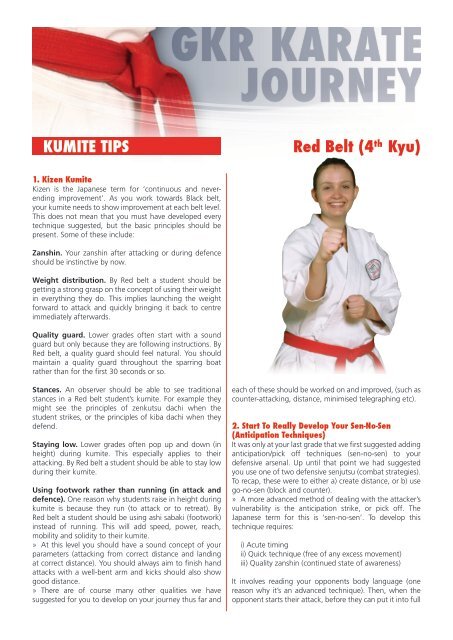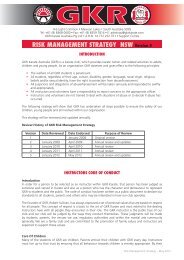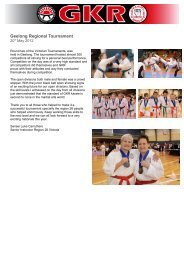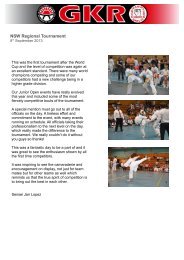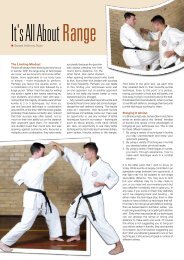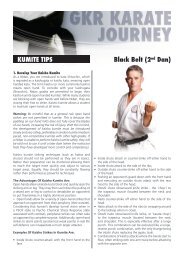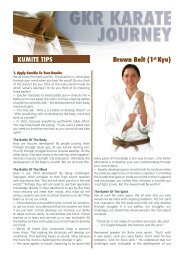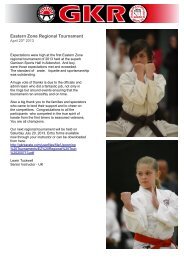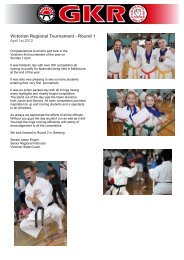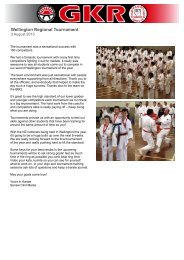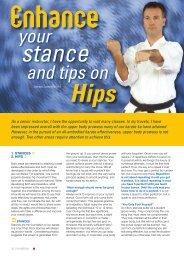Red Belt (4th Kyu) KumiTe TipS - GKR Karate
Red Belt (4th Kyu) KumiTe TipS - GKR Karate
Red Belt (4th Kyu) KumiTe TipS - GKR Karate
Create successful ePaper yourself
Turn your PDF publications into a flip-book with our unique Google optimized e-Paper software.
Kumite Tips<br />
<strong>Red</strong> <strong>Belt</strong> (4 th <strong>Kyu</strong>)<br />
1. Kizen Kumite<br />
Kizen is the Japanese term for ‘continuous and neverending<br />
improvement’. As you work towards Black belt,<br />
your kumite needs to show improvement at each belt level.<br />
This does not mean that you must have developed every<br />
technique suggested, but the basic principles should be<br />
present. Some of these include:<br />
Zanshin. Your zanshin after attacking or during defence<br />
should be instinctive by now.<br />
Weight distribution. By <strong>Red</strong> belt a student should be<br />
getting a strong grasp on the concept of using their weight<br />
in everything they do. This implies launching the weight<br />
forward to attack and quickly bringing it back to centre<br />
immediately afterwards.<br />
Quality guard. Lower grades often start with a sound<br />
guard but only because they are following instructions. By<br />
<strong>Red</strong> belt, a quality guard should feel natural. You should<br />
maintain a quality guard throughout the sparring boat<br />
rather than for the first 30 seconds or so.<br />
Stances. An observer should be able to see traditional<br />
stances in a <strong>Red</strong> belt student’s kumite. For example they<br />
might see the principles of zenkutsu dachi when the<br />
student strikes, or the principles of kiba dachi when they<br />
defend.<br />
Staying low. Lower grades often pop up and down (in<br />
height) during kumite. This especially applies to their<br />
attacking. By <strong>Red</strong> belt a student should be able to stay low<br />
during their kumite.<br />
Using footwork rather than running (in attack and<br />
defence). One reason why students raise in height during<br />
kumite is because they run (to attack or to retreat). By<br />
<strong>Red</strong> belt a student should be using ashi sabaki (footwork)<br />
instead of running. This will add speed, power, reach,<br />
mobility and solidity to their kumite.<br />
» At this level you should have a sound concept of your<br />
parameters (attacking from correct distance and landing<br />
at correct distance). You should always aim to finish hand<br />
attacks with a well-bent arm and kicks should also show<br />
good distance.<br />
» There are of course many other qualities we have<br />
suggested for you to develop on your journey thus far and<br />
each of these should be worked on and improved, (such as<br />
counter-attacking, distance, minimised telegraphing etc).<br />
2. Start To Really Develop Your Sen-No-Sen<br />
(Anticipation Techniques)<br />
It was only at your last grade that we first suggested adding<br />
anticipation/pick off techniques (sen-no-sen) to your<br />
defensive arsenal. Up until that point we had suggested<br />
you use one of two defensive senjutsu (combat strategies).<br />
To recap, these were to either a) create distance, or b) use<br />
go-no-sen (block and counter).<br />
» A more advanced method of dealing with the attacker’s<br />
vulnerability is the anticipation strike, or pick off. The<br />
Japanese term for this is ‘sen-no-sen’. To develop this<br />
technique requires:<br />
i) Acute timing<br />
ii) Quick technique (free of any excess movement)<br />
iii) Quality zanshin (continued state of awareness)<br />
It involves reading your opponents body language (one<br />
reason why it’s an advanced technique). Then, when the<br />
opponent starts their attack, before they can put it into full
swing, move in with your own technique. Your technique<br />
should not only land first, it should prevent them from ever<br />
finalising theirs.<br />
» This technique will take years to develop but is highly<br />
effective in self-defence. It’s worth noting that it is much<br />
easier to use in self-defence because:<br />
i) You will unlikely be up against a trained attacker.<br />
ii) Your attacker is unlikely aware that you train in martial<br />
arts.<br />
iii) Your attacker will likely throw swinging techniques,<br />
which are much slower than the karate Lunge or<br />
Reverse Punch.<br />
Your <strong>Red</strong> belt is a catalyst to start developing this technique.<br />
Sen-no-sen becomes valuable in self-defence because a<br />
smaller defender can identify the opportunity to strike their<br />
larger attacker’s vulnerable points mid-attack. This means<br />
they do not have to try to block, absorb or retreat from the<br />
larger attacker’s heavy blow.<br />
» Having trained with Bassai-dai for some months now, a<br />
student would be starting to well-equip themselves with<br />
principles required to perform an effective sen-no-sen<br />
technique.<br />
Some of the principles of sen-no-sen that Bassai-dai<br />
develops are:<br />
i) Developing straight line attacks. This enables you to<br />
quickly bridge the gap between your attacker, and<br />
ensures all your energy (mass) travels directly into the<br />
target area.<br />
ii) Developing explosive movements from the very<br />
beginning of a technique and continuing this through<br />
until the technique has been completed.<br />
iii) Landing in a strong stance with a technique<br />
encompassing full kime (a focus of energy).<br />
iv) Putting full kime into techniques in a short space.<br />
This is essential for close quarter combat.<br />
v) Moving forward with strikes that can - if needed -<br />
be turned into blocks (eg, knife hand block/strike in<br />
kokutsu dachi).<br />
A good place to start developing your sen-no-sen is<br />
against:<br />
i) Kicks. This is because they must travel further.<br />
Therefore it’s often a good opportunity to step in and<br />
strike before your opponent gets their knee up and<br />
attempts to extend their kick.<br />
ii) Opponents who make their intention clear (telegraph)<br />
that they are about to attack. Many students will rise<br />
in stance before attacking. Others might pull their<br />
hand back etc. You can start to really hone your<br />
sen-no-sen skills against these opponents. As you<br />
become more proficient you can start to implement<br />
them against more highly skilled opponents.<br />
3. Practise At Home<br />
At <strong>Red</strong> belt your focus will be on refining all the kumite<br />
principles and techniques you have learned to date. It’s<br />
also a great time to really start developing your ability to<br />
apply some of the kata senjutsu (combat principles found<br />
in kata) to practise.<br />
» If you really wish to develop your kumite skills and<br />
achieve all this, it is advisable to start training at home.<br />
Home training allows you to focus purely on yourself<br />
rather than sharing your focus between yourself and an<br />
opponent. This means you can make giant leaps in your<br />
progress in a short space of time.<br />
» Home kumite training does not necessarily mean invite<br />
a friend over and spar - although you could of course do<br />
this providing you have a safe environment to do so. Home<br />
kumite predominantly involves practising techniques and<br />
principles by yourself to develop your ability and confidence<br />
to use them. Things to work on are:<br />
Shadow sparring: This can involve moving around in a<br />
small space and sparring an imaginary opponent. Moving<br />
around a small space develops your ability to work in a<br />
confining space (more similar to actual self-defence).<br />
Footwork drills: This can encompass using different<br />
footwork drills to attack. Always focusing on staying low,<br />
and in a well-balanced stance.<br />
Breathing: Training for half an hour or longer on kumite<br />
at home will test your fitness. You can help to control this<br />
by supplying your muscles with ample amounts of oxygen.<br />
Correct breathing is a great habit one can develop through<br />
home training because we often hold our breath out of<br />
anticipation for what an opponent might do.<br />
Attacking drills: Your favourite attacking drills can be<br />
done slow, medium and fast multiple times so they become<br />
instinctive.<br />
Defensive drills: When these become instinctive you will<br />
feel an enormous lift in your confidence to block, sidestep,<br />
counter, pick off etc.<br />
Kicks to a target: One reason why students don’t kick<br />
often in kumite is that they do not trust their control.<br />
When you practise kicking a target (eg a tree branch, a<br />
mitt hanging on a string etc) you develop confidence in<br />
your ability to control your kicks.<br />
Bag work: Hitting a bag (eg punching bag or kick shield)<br />
will develop your fitness, technique, strength, speed and<br />
technique.<br />
4. Develop Your RTBP (Relax Tense Balance Point)<br />
With so much to think about, it’s often difficult for students<br />
to relax during kumite. A busy mind tends to confuse the<br />
muscles into tensing up.<br />
» We introduced you to the concept of ibuki waza in the<br />
Blue belt section of ‘The Journey’. Working on correcting
your breathing will play a large role in helping you to relax<br />
more during not only kumite, but also your kihon and<br />
kata.<br />
» Now that at <strong>Red</strong> belt our primary goal is to refine<br />
everything we know, and embed it in our instinctive<br />
subconscious, we have room in our mind to really work on<br />
relaxing our body.<br />
» If you are not aware of the benefits of being relaxed in<br />
your karate; there are many:<br />
Energy conservation: Enormous amounts of energy are<br />
wasted because muscles hold excess tension. Students<br />
will often say, “I’m not fit enough.” But the real culprit is<br />
not their fitness, but rather the excess energy lost through<br />
excess tension.<br />
Speed: Tension in the body is like driving a car with the<br />
hand brake on. Learning to relax will allow your muscles to<br />
move at full speed.<br />
Power: Power comes from the combination of both mass<br />
(weight) and velocity (speed). If you can move faster you<br />
can strike harder. What’s more, excess tension prevents the<br />
small movements that are required for extra power (such<br />
as hip rotation) from taking place.<br />
» Having achieved a fairly sound level of mastery over your<br />
body, you can start to develop your RTBP (your relax tense<br />
balance point).<br />
So what is your RTBP?<br />
You have probably been told to relax a hundred times or<br />
more during your karate. But you can’t completely relax.<br />
If you did you would literally fall over! How can you hold<br />
your guard up if you are completely relaxed, would your<br />
arms not swing by your sides?<br />
» This is where your RTBP comes into play. It’s developing<br />
an understanding of each muscle and how much tension<br />
actually needs to hold. In essence, you need just enough<br />
tension to hold form. Any less tension and you lose form,<br />
any more tension and you will lose speed and power.<br />
The RTBP Test<br />
A good test to develop your RTBP is to do a few push ups<br />
(press ups). Get into position and tighten every muscle you<br />
can think of (your feet, calves, hamstrings, quads, abs,<br />
back, arms, neck, face etc). Tighten every single muscle as<br />
tight as you possibly can and then maintain 100% tension<br />
while performing 2 or 3 push ups. You will find it not only<br />
exhausting but extremely difficult to do. This is obviously<br />
an example of excess tension to the extreme.<br />
» Next relax every single muscle to 100% relaxation. Ok,<br />
now it’s impossible to get off the floor.<br />
» So therefore somewhere between full tension of every<br />
muscle, and no tension in any muscle, there is a balance<br />
point. For the push up example, you can work out which<br />
muscles you need tensed, and which need no, or little<br />
tension, to get the job done.<br />
Do I Ever Need 100%?<br />
It’s often said, at the very end of a technique, when you<br />
apply full kime that you need to tense up every muscle as<br />
hard as you can for a milli-second. For lower grades this is<br />
probably quite accurate because if they don’t tense up they<br />
are likely to injure themselves.<br />
» As you progress through your karate journey you will<br />
come to realise that you never need 100% tension. Not<br />
even in your fist. You will actually be able to hit harder than<br />
you ever have while remaining quite relaxed - even at the<br />
point of impact. This is not something for you to develop<br />
right now, its something to look forward to in the future.<br />
Right now, just look to remove excess tension in every area<br />
outside of impact in our karate.<br />
5. Implement Kata Senjutsu Into Kumite<br />
Kumite is a physical expression of your karate. It allows you<br />
to demonstrate your knowledge of technique and senjutsu<br />
(strategy).<br />
Taigyoku Kumite: While you may not be an expert, a <strong>Red</strong><br />
belt should be able to demonstrate the principles of the<br />
Taigyoku kata in their kumite.<br />
Saifa Kumite: With different types of movement and<br />
principles, a <strong>Red</strong> belt should be able to demonstrate to<br />
some degree, Saifa in their kumite.<br />
Bassai-dai Kumite: We did not recommend that you<br />
work on implementing Bassai-dai into your kumite at Blue<br />
belt. This would have given you too much to think about;<br />
especially seeing Bassai-dai was not instinctive to you.<br />
» Being <strong>Red</strong> belt does mean that you know Bassai-dai quite<br />
well and that you can start to think about implementing<br />
it into your kumite. This will not only develop your<br />
understanding of the kata, it will actually help your kata<br />
performance because you will be using your body in a<br />
similar way to the kata.<br />
Examples of using Bassai-dai in kumite are:<br />
a) Quality hip movement. During Bassai-dai we execute<br />
large and powerful hip rotations when we execute renuke<br />
(two blocks with alternate arms). In kumite it is a<br />
great idea to start really focusing on this hip movement<br />
when executing ren tsuki (two arms striking alternatively,<br />
for example, lunge punch followed by reverse punch).<br />
» Some students get to <strong>Red</strong> belt and they still hardly<br />
use their hips in their kumite. This shows that they are<br />
neglecting the important lessons in their kata. Quality<br />
hip movement should also occur when you execute<br />
single reverse punches and counter-strikes. One can<br />
easily see how working on the sharp, twisting of the<br />
hips in kumite will come back and help their kata.<br />
b) Maintaining deep, well-grounded stances while<br />
defending. Bassai-dai promotes this principle. To see<br />
<strong>Red</strong> belts forever running away when defending shows<br />
they are not thinking about the skills their kata is trying<br />
to instil in them. Of course there are times to flee, but<br />
there should be times where you adopt a well-grounded<br />
last stand.
c) Turning the defender on their axis. In Bassai-dai, we<br />
don’t just execute blocks. We block with one arm, and<br />
with our second arm, execute a follow up block (ren<br />
uke) in the attempt to either control our opponent or to<br />
turn them on their axis (exposing their sides or back).<br />
» Other examples of how Bassai-dai can be implemented<br />
in sparring are explode forwards in straight line<br />
movements, getting to the outside of an attacker by<br />
stepping the front foot past the opponent’s front foot<br />
etc.<br />
» There are also techniques such as sweeps and<br />
takedowns. But these are not yet permitted at <strong>Red</strong><br />
belt.<br />
6. Develop Your Own Senjutsu (Strategy)<br />
How would you describe your sparring style? When<br />
observing a karate-ka spar, you should not see them use<br />
the same style of kumite against every opponent they face.<br />
You should see them adapt their style according to their<br />
opponent.<br />
» There is a Japanese saying that “A light wind is unable<br />
to move an Oak tree. It stands strong and defiant. But the<br />
light wind is able to push the grass around to and fro.<br />
However the strongest of winds are able to uproot the<br />
Oak tree - who tried to stand defiant. Yet the strongest of<br />
winds are unable to uproot grass because it moves to and<br />
fro.” The point is, sometimes we need to be an oak tree<br />
and sometimes we need to be the grass. This is but one<br />
example of why we need to change our style of fighting.<br />
» Up until <strong>Red</strong> belt you have simply been trying to get good<br />
at what you already know while trying to add to this new<br />
techniques and principles. Now that you are starting to get<br />
a hold of these it’s important that you start understanding<br />
when each one can be best used.<br />
» Let’s look at defence as an example. To date we have<br />
discussed creating distance (via retreating or side-stepping),<br />
blocking and countering, anticipating (pick offs) and just<br />
recently, using the principle of Bassai-dai of turning an<br />
opponent on their axis with the use of two blocks (ren<br />
uke). The big question is, when is the best time to use<br />
each one?<br />
» Then there is the question of attacking. For example,<br />
when is the best time to use a side kick? Is there one?<br />
» Having reached a fair level of conscious competence,<br />
it’s time to start thinking about strategy. Gichen Funakoshi<br />
had 20 precepts for training. Of these was, “Tattakai wa<br />
kyo-jitsu no soju ikan ni ari,” which translates roughly<br />
as “Transform yourself according to the opponent.”<br />
Funakoshi also wrote ‘the secret of combat resides in the<br />
art of directing it (strategy).”<br />
Think about each type of opponent you might come up<br />
against. Some examples are:<br />
• Fast people<br />
• Strong people<br />
• Good counter attackers<br />
• Good kickers<br />
• Good strikers<br />
• People who pick off well<br />
• Offensive minded people<br />
• Offensive minded people who generally attack with<br />
multiple attacks<br />
• Offensive minded people who generally attack with<br />
singular and/or double techiques<br />
• People who stand very still<br />
• People who move around a lot<br />
Now think about what techniques or strategies would best<br />
serve you against each type of person.<br />
» The following is an example against an opponent who<br />
has an excellent sen-no-sen (anticipation technique or pick<br />
off):<br />
a) Feint attacking often to upset their rhythm and help<br />
reveal their intentions. Having revealed their intention,<br />
it will cause hesitation in them.<br />
b) Move around a lot. This will prevent them from getting<br />
settled in a poised stance. To pick off, most people want<br />
to feel poised in a stance they can spring out of. If they<br />
are constantly moving to adjust to your movements (eg<br />
circling) they will be unable to do this.<br />
c) Throw the occasional side kick off the front foot into<br />
their lower stomach. If this is done quickly, they will<br />
not be able to get in before you execute it. But it also<br />
diminishes their confidence because most people do not<br />
wish to run in to a side kick.<br />
While there have been many articles (found in the Training<br />
category of the Articles section) that offer many strategies<br />
for kumite, it’s important that you take time to think of<br />
your own.<br />
» This will help you assess your own level of understanding<br />
of techniques and principles.<br />
» It will also teach you to think about strengths and<br />
weaknesses of techniques and strategies.<br />
7. Disturb Your Opponent’s Guard With Your Hands<br />
At Green belt we introduced you to the idea of feinting<br />
with your hands. At Blue belt we introduced you to the<br />
idea of feinting with your legs. One of the strategies behind<br />
feinting was to disrupt your opponent’s thoughts. In short,<br />
it’s hard to strategise when your opponent’s movements<br />
continually disrupt your thoughts.<br />
» Disturbing your opponent is a step above feinting and in<br />
many ways can be considered an advanced version of the<br />
feint. So what does disturbing involve?<br />
» The Start and Stop version of the feint (see the Green<br />
<strong>Belt</strong> section) required a person to quickly step their front<br />
foot out slightly and partly execute a technique before<br />
quickly retreating back to their fighting stance.<br />
» The disturb takes this one step further. The goal is to<br />
actually make contact with your opponent’s guard. While<br />
you can step and reach out and touch your opponent’s<br />
guard with your rear hand, it is advised to develop the skill<br />
using your front hand.<br />
» This was not suggested prior to <strong>Red</strong> belt because it<br />
requires you to get closer to your opponent, and if one
is not careful they might be attacked and scored upon<br />
during the process. Having achieved your <strong>Red</strong> belt, your<br />
fighting stance and footwork should be adequate enough<br />
to allow you to tap into your opponent’s guard without<br />
endangering yourself.<br />
The three keys to making this technique a success is as<br />
follows:<br />
i) Be quick with your front foot step and reach out. If<br />
you are slow you will find yourself in hot water.<br />
ii) Zanshin. Be aware your opponent may strike and be<br />
quick to get back to your guard.<br />
iii) Be prepared. Being aware is not enough, you must<br />
be prepared to counter strike or retreat should your<br />
opponent attack.<br />
It does not require any power, merely touching your<br />
opponent’s forearm or hand.<br />
» Be sure to touch from top position (rather than touching<br />
the bottom of their hand or forearm). Having your hand<br />
on top allows you to more effectively block should they<br />
attack, plus it allows you to lever their hand downwards<br />
and strike should you wish to.<br />
» So if this senjutsu (combat strategy) is more difficult<br />
than the feint, why should we use it?<br />
a) It disturbs their thinking. This prevents them from<br />
establishing attacking strategies as they are concerned<br />
about your potential attack.<br />
b) Advanced opponents are very good at distinguishing<br />
the difference between real attacks and feints.<br />
c) Advanced opponents rarely react until a technique is<br />
inside their reach.<br />
d) It encourages your opponent to attack. If you want your<br />
opponent to attack (allowing you to counter strike), this<br />
technique will often draw out their attack.<br />
e) It sets precedence. If you get inside your opponent’s<br />
range often (just to touch and retreat) they lose their<br />
sense of urgency each time you move forward. This<br />
happens subconsciously in kumite, where we start to<br />
feel we can predict our opponent’s movements. When<br />
you sense they have lost their sense of urgency to react,<br />
use your disturb tactic to get in close and lever their<br />
hand down - continuing on with a strike.<br />
8. Be A Moving Weapon, Not A Moving Target<br />
Some people hesitate to attack in kumite because they<br />
fear being picked off. Of course one trick is to get faster,<br />
but a more simple method is to put your opponent on the<br />
defensive before you start.<br />
» Think about the psychology for a moment. If you<br />
charge in with your body, waiting to get into range before<br />
throwing your first attack, what does your opponent see?<br />
A moving target! Hardly something intimidating to put you<br />
on the back foot.<br />
» It can pay dividends to launch your first attack while<br />
still short of your opponent. Sure it will be short but what<br />
do they see? A weapon moving towards them! Therefore<br />
their most likely reaction is to go into a defensive mindset<br />
(hence try to block). Now considering your first attack will<br />
land short, don’t forget to throw a second attack, because<br />
this now becomes your true intended attack.<br />
9. Empty Hand Doesn’t Imply No Weapons<br />
It is commonly known that the ‘te’ in ‘Kara-te’ means<br />
hand. The ‘Kara’ part originally meant China. So kara-te<br />
translated as ‘China-hand’. In 1936, the Okinawa masters<br />
decided that the term China was no longer appropriate as<br />
karate no longer resembled Chinese arts. It has evolved to<br />
become its own original art.<br />
» So the kanji that symbolised the ‘Kara’ component was<br />
changed to one that translated as ‘Empty’. So kara-te now<br />
translated as ‘empty-hand’.<br />
» Because of this translation however, people often<br />
presume that ‘empty-hand’ means ‘no weapons’.<br />
Therefore, when confronted with a real life situation, most<br />
karate-ka will naturally resort to focusing on using their<br />
body as a weapon in self-defence.<br />
» While it is true that, by-and-large, karate is an unarmed<br />
form of self-defence, it does not mean that a karate-ka<br />
should neglect weapons. To begin with, a number of<br />
the old Okinawa masters (who formed the name ‘empty<br />
hand’) actually trained with weapons. And the majority<br />
of the weapons practised were regular household items<br />
or farming tools. Even a number of kata practised today<br />
were also practised with weapons. For example, Kururunfa<br />
is often practised as a Sai kata (Sai was a weapon taken<br />
from farming tools) and Sepai is often practised as a sword<br />
kata.<br />
» Secondly, one must remember that karate does not<br />
teach a set of appropriate responses to a limited number<br />
of self-defence scenarios. Rather, it teaches self-defence<br />
principles that could work in any situation. Therefore,<br />
whether you are unarmed, or have something in your hand,<br />
the principles found in karate can be used identically.<br />
» In other words, if you are ever confronted, if anything<br />
is in your vicinity that could be used as a weapon (eg a<br />
chair, a bin lid, your belt or high heel shoe, a handbag, a<br />
book, car keys etc) then be sure to grab it. The principles<br />
of karate can still come out because a weapon is no more<br />
than an extension of the body.<br />
» Don’t change the principles to your kumite. Keep your<br />
stance, use your body in your techniques, maintain zanshin<br />
etc. What you are doing is practising these principles with<br />
something in your hand. This will not only train you but<br />
help to remind you to look for weapons (big or small, sharp<br />
or blunt etc) should you ever get attacked.<br />
10. Never Forget: <strong>Karate</strong> Begins With Rei And<br />
Ends With Rei<br />
Having reached <strong>Red</strong> belt, it’s likely that your kumite will<br />
start to become a little more competitive. When this<br />
occurs we may find ourselves getting the occasional knock.<br />
Furthermore as both we and our fellow students will be<br />
experimenting with new techniques and principles, bouts<br />
may get a little scrappy. It’s important during these times
to remember that ‘<strong>Karate</strong> begins and ends with rei’. Rei,<br />
represented by the bow, represents courtesy and respect.<br />
» This is not only an important concept to remember for<br />
kumite, but for our lives in general.<br />
» Seeing students get angry in kumite shows an instructor<br />
that the student is yet to develop their attitude. Anger<br />
clouds our judgement and causes us to act out irrationally.<br />
This makes for an unsafe kumite environment and puts us<br />
in a vulnerable position during self-defence. It also detracts<br />
from the quality of our life outside the dojo.


